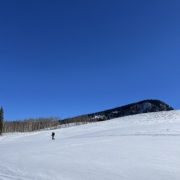Prepare for the Unexpected: Winter Emergency Skills
Inclement weather, snow-covered terrain, and cold temperatures can add extra spice to any winter backcountry outing. With good gear and knowledge, you can be prepared for an unexpected situation, regardless of the temps or your location. We may be biased, but we think there’s no better place to learn these skills than in person at Bluebird Backcountry. This season, we’ve launched a new course, Winter Emergency Skills — a full-day, interactive course covering the basics of cold-weather survival skills in the best classroom around.
Here’s a taste of their Winter Emergency Skills course, along with gear recommendations from Bluebird’s team for staying warm when exploring in winter environments.
Students practice the Burrito Wrap technique in Bluebird’s Winter Emergency Skills Course. Photo: Justin Wilhelm
Skills to Acquire
When learning to backcountry ski or splitboard, there are some basic skills you need to know that can be acquired through Bluebird’s education progression. These skills include the following; how to transition from uphill to downhill mode, what to carry in your pack and how to use your gear.
Once you’ve mastered the basics, it’s time to move on to more advanced skills and take your riding to the next level. Winter Emergency Skills teaches the critical competencies you need to feel confident traveling in the backcountry. Here’s a brief overview:
1. Making a Shelter
There’s many ways to build an emergency shelter, but deep snow and available resources may limit the options. Snow acts as an insulator — if it’s windy or frigid, consider digging into the snow for protection. If there’s enough snow, you can dig a trench into the side of a hill. Make sure it’s deep enough to fit your whole party then over the trench with your emergency tarp or shelter. Another option is to build a lean-to shelter or makeshift wind-break with branches. You can spread your tarp on top to provide extra protection.
Students build a shelter in Bluebird Backcountry’s Winter Emergency Skills Course. Photo: Justin Wilhelm
2. Creating Heat
There are many ways to build heat in the backcountry — movement being number one — but once you stop moving it becomes a lot harder to stay warm. Start by putting on warm, dry layers. Insulating layers only retain heat, so it’s important to build up warmth before you stop moving… jumping jacks or burpees always do the trick. If you’re caring for an injured person, or stuck for an extended period of time, the best thing to do is build a fire. This provides heat and helps you melt snow if you need drinking water.
Learn how to make a fire in cold environments and put together fire starters for your backcountry kit in Bluebird’s Winter Emergency Skills course!
3. Signaling for Help
Depending on your location in the backcountry, you may or may not have cell service. A satellite phone or SOS communication device (Garmin InReach, etc) is an essential item to carry for all winter recreationists. Finding a high point, like a ridge or summit, will sometimes provide better service. Even when you don’t have service, always try calling 911. When 911 is dialed on cell phones the signal is boosted to include all carriers in the region, so you may be able to get a call through.
If none of the above work, it’s time to start using old-school tactics. If you have a fire, add green debris to make a smoke signal. Hang a bright piece of clothing in an open field for helicopters to see, and carry a whistle to call for help.

Students discuss what to do in an emergency situation at Bluebird Backcountry. Photo: Justin Wilhelm
What to Carry
Whether you’re planning a simple half-day outing or long ski traverse, it’s important to have the essentials in case of injury or an emergency situation that requires staying overnight in the backcountry. Always pack extra food and water, warm layers, a first aid kit, fire starters, knife, SOS device, and some form of tarp. Here are the best items for staying warm and dry in the snow:
- Hers and his ultralight yet incredibly cozy down jackets.
- Breathable mid-layer jacket – Bluebird employees basically live in this jacket all winter.
- Sleeping bag for extra warmth – Aim for a zero degree temperature rating.
- Foam pad to sit/lay on – This can double as a splint or emergency sled if needed.
- Inflatable Pad — For added comfort, if you’ve got the extra space.
- Tarp – To be used as a shelter, makeshift sled, or to protect an injured person from the elements.
Bluebird employees gather at the base area after a day on the mountain, clad in Big Agnes to stay warm. Photo: Erik Lambert
If you’re interested in diving deeper into these topics, check out Bluebird’s Winter Emergency Skills Advanced Course. You’ll get hands-on practice with building shelters and making fires, discuss how to care for injured persons when in remote locations, and breakout Big Agnes’s gear to practice all of the above.














